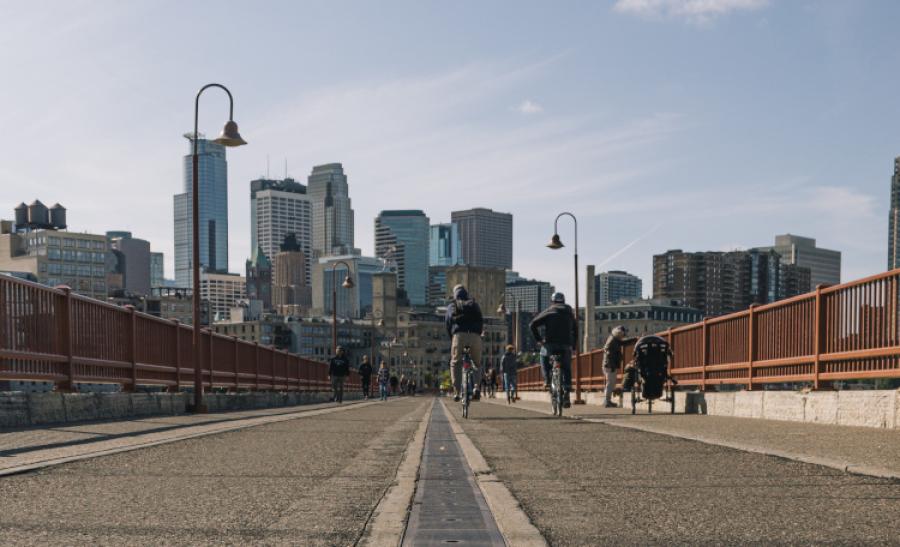From the Archives – “Hope Is Here!”
Image

While attending seminary, my wife and I rented a tiny apartment in the inner city. In three short years, we witnessed more crime and violence than one might see in a month of TV police shows. Within a block of our home, we saw street fights, guns, prostitution, drug activity, car thefts, stalking and more.
One night, our elderly next door neighbors were dragged out onto their front lawn, beaten and robbed. A man was shot to death on the street a half block from our home. In the parking lot below our living room window, I saw one man hold a gun to another man’s head in broad daylight. Drunks sometimes slept on our front steps. Men repeatedly harassed my wife on the street.
There are some things about living in that neighborhood I will never miss. There are other things, however, that I miss desperately. What I may miss most, is the consistent opportunity to speak with people—even complete strangers—who were willing to talk freely about the miseries of life and the emptiness of their soul. I loved that environment.
It was in this context that I met Darryl. Darryl talked about the inequities and miseries of life as comfortably as suburbanites talk about the weather. With considerable ease he relayed memories of a haunted childhood: divorced parents; a dad who lived down the street but never spoke to him; desperate poverty; cowering in fear under the kitchen table as his gun wielding brothers came home with another take of stolen property.
Darryl was a troubled soul. He was desperately poor, psychologically unstable, and enslaved to numerous destructive habits. The refreshing thing was, Darryl was not afraid at all to discuss his misery. In fact, he was almost desperate to talk to anyone who could help him cope with life. I surmise that is the only reason he ever talked to me—a complete stranger—in the first place.
Over time, I explained to Darryl that Jesus Christ paid the debt of our sin by bearing the divine sentence against human guilt in His own body on the cross. I explained that Christ defeated death by rising from the grave and that, in light of these biblical truths, God could wash Darryl’s sins away and set his soul free. Darryl listened. Slowly, he began to understand. Eventually, he believed.
Darryl was not transformed into a “normal guy” overnight, but he had found hope. And, true to form, he wasn’t afraid to let others know about it.
As part of my seminary training, I stood on a busy street corner from time to time, handing out Christian literature and seeking to offer hope on the streets. I’m not a natural at such bold approaches, but I was dutifully seeking to make a difference in my neighborhood.
On one such outing, I spotted Darryl walking toward me down the busy sidewalk. He wore a new, black T-shirt. Emblazoned across the chest in bold white letters was the message: “HOPE IS HERE.” He asked me what I was doing and I explained myself. Before I knew what was happening, he had my literature in hand, walked right into the busy street, and began speaking to the drivers of cars that were stopped at a traffic light. Moving from car to car, he addressed each bewildered driver courteously, but boldly: “Here, want some hope?”
Part of me wanted to crawl in a hole and pretend I did not know Darryl. On the other hand, I was proud of him—and not a little rebuked by his enthusiasm for the hope that now possessed him.
I miss that neighborhood. I miss those days. And, as life circumstances would have it, I miss Darryl. People here in suburbia seem far less willing to talk sometimes, but I try to remind myself that, despite physical location, the human heart is naturally restless and in need of hope. Well, to borrow Darryl’s line, “hope is here,” and that’s good news no matter where you live.
Photo by Weston MacKinnon on Unsplash.
Pastor Dan Miller Bio
Dan Miller has served as the Senior Pastor of Eden Baptist Church since 1989. He graduated from Pillsbury Baptist Bible College in 1984 and his graduate degrees include the MA in history from Minnesota State University, MDiv and ThM from Central Baptist Theological Seminary and DMin from Trinity Evangelical Divinity School. Dan is married to Beth and the Lord has blessed them with four children: Ethan, Levi, Reed and Whitney.
- 12 views
Thanks, Dan. I enjoyed this article.
G. N. Barkman


Discussion